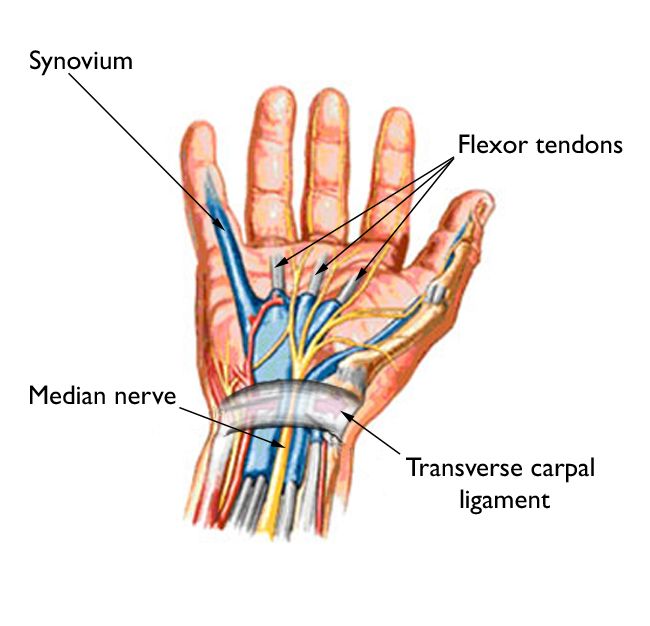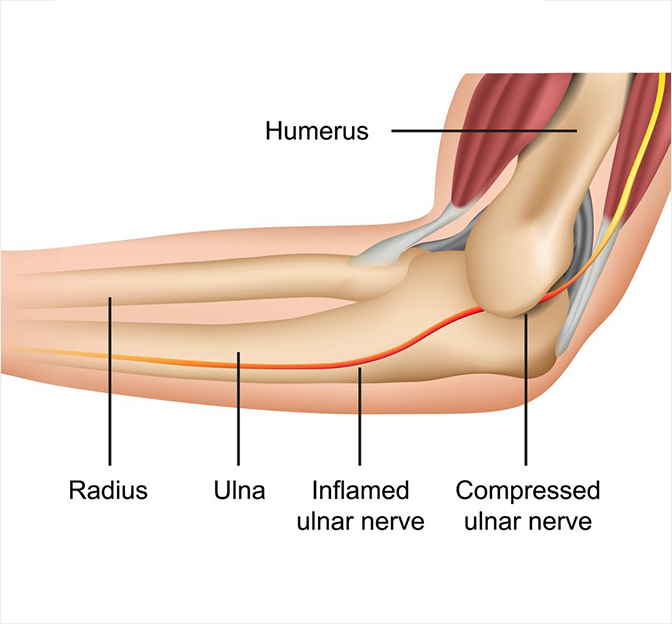| Carpal Tunnel Syndrome |

| The etiology of carpal tunnel syndrome is pressure on the median nerve. On the hand's palm side, the carpal tunnel is a small opening encircled by bones and ligaments. Compression of the median nerve can cause a variety of symptoms in the hand and arm, including numbness, tingling, and weakness. Carpal tunnel syndrome may be caused by the anatomy of the wrist, health concerns, or repeated hand movements. Tingling and numbness are frequently relieved by proper treatment, as is wrist and hand function. Symptoms Numbness or tingling: Tingling and numbness in the fingers or hand are possible symptoms. The thumb, index, middle, and ring fingers are usually affected, but not the little finger. You may experience an electric shock sensation in these fingers. |
Many people try to feel better by "shaking out" their hands. Over time, you might feel numb all the time.
-Weakness: You can feel hand weakness and drop objects. This may be related to numbness in the hand or the median nerve-controlled weakening of the pinching muscles in the thumb.
| How to Treat ? |
After onset of symptoms, carpal tunnel syndrome should be treated as soon as feasible. In the early stages, modest self-care measures may be sufficient to resolve the issue. For instance:
- Take more regular breaks to give your hands a chance to relax.
- Stay away from anything that makes your symptoms much worse.
- Applying cold packs will help lessen the swelling in your face.
Wrist bracing, medicine, and surgery are three other treatment options that may be considered. If you have only experienced mild to moderate symptoms that have come and gone for less than ten months, splinting and other conservative treatments like physical therapy have a better chance of helping you. You should seek medical attention as soon as possible if you notice tingling or numbness in your hands.
| Non-Surgical Theraphy |
| Splinting of the wrist |
Tingling and numbness are common nocturnal symptoms that can be alleviated with the use of a splint that immobilizes the wrist while the wearer sleeps. Even though you only have to wear the splint while you sleep, it still has the potential to help prevent symptoms during the day. Because it does not require the use of any pharmaceuticals to be effective, nighttime splinting may be an option worth considering if you are expecting a child because of its safety profile.
| Non-steroidal anti-inflammatory medications (NSAIDs) |
Short-term relief from carpal tunnel syndrome discomfort may be provided by NSAIDs like ibuprofen (Advil, Motrin IB, and others).
There is no proof that these medications improve carpal tunnel syndrome, though.
| Corticosteroids |
Cortisone or another corticosteroid may be injected into the carpal tunnel to ease pain. Sometimes, an ultrasound is used to guide these injections.
The reduction of inflammation and edema by corticosteroids lowers strain on the median nerve. Injections of corticosteroids are considered more beneficial than oral corticosteroids for treating carpal tunnel syndrome.
| Surgery |
If the symptoms are severe or do not respond to previous therapies, surgery may be necessary.
The purpose of carpal tunnel surgery is to relieve pressure on the median nerve by severing the ligament pressing on it.
The operation may be conducted using two distinct methods:
| Endoscopic Surgery |
To inspect the carpal tunnel, your surgeon will use an endoscope, a telescope-like instrument with a miniature camera connected to it. During the procedure, your surgeon makes one or two tiny incisions in your hand or wrist and slices the ligament. Ultrasound may be used instead of a telescope by some surgeons as they direct the instrument that makes the incision in the ligament.
While all surgeries cause some degree of discomfort in the days and weeks following their completion, endoscopic procedures have the potential to cause less pain than open procedures do.
| Open Surgery |
Your doctor will make a cut in your palm over the carpal tunnel and release the nerve by cutting through a ligament.
Talk to your surgeon about the potential downsides and upsides of each procedure. Possible complications after surgery include:
The ligament has not been completely released.
Infections of the wound
Scar development
Neurological or blood vessel injuries
During the healing process after surgery, the tissues of the ligaments slowly grow back together, giving the nerve more room. Most of the time, this internal healing takes a few months, but the skin heals in a few weeks.
After the ligament has healed, your physician will typically encourage you to gradually return to normal hand use, while initially avoiding vigorous hand motions or extreme wrist positions.
After surgery, it may take several weeks to a few months for pain or weakness to subside. If your symptoms were extremely severe, they may not totally go following surgery.

Talk to your surgeon about the potential downsides and upsides of each procedure. Possible complications after surgery include:
The ligament has not been completely released.
Infections of the wound
Scar development
Neurological or blood vessel injuries
During the healing process after surgery, the tissues of the ligaments slowly grow back together, giving the nerve more room. Most of the time, this internal healing takes a few months, but the skin heals in a few weeks.
After the ligament has healed, your physician will typically encourage you to gradually return to normal hand use, while initially avoiding vigorous hand motions or extreme wrist positions.
After surgery, it may take several weeks to a few months for pain or weakness to subside. If your symptoms were extremely severe, they may not totally go following surgery.
| Cubital Tunnel Syndrome |

Among the three main nerves that pass the elbow, the ulnar nerve is one (the others are the median and radial nerves). The ulnar nerve runs across the elbow on the medial (inside) side. It is very close to the medial ulnar collateral ligament. It enters the cubital tunnel as it crosses the elbow joint. This tunnel is made of bone on one side and ligament on the other. Because this space is so small, the nerve is frequently compressed. This compression is known as "cubital tunnel syndrome," and it can cause nerve problems such as pain, weakness, numbness, and even muscle atrophy.
In addition to nerve compression, nerve instability (in which the tunnel is excessively loose and the nerve moves more than it should) can also produce ulnar nerve discomfort.
The radial nerve is one of the three forearm nerves, and it runs from the side of your neck, down the back of your arm, through your forearm, and into your hand. The radial nerve controls numerous actions in your arms, such as turning your forearm, extending your elbow, and flexing and straightening your wrists and fingers. The radial tunnel is a bundle of muscles that the nerve travels through on its way to the elbow.
Pinching or compression of the radial nerve as it enters the radial tunnel leads to radial tunnel syndrome. This puts unnecessary strain on your radial nerve, which can lead to persistent discomfort.
 Brachial Plexus Injuries
Brachial Plexus Injuries
The signals from the spinal cord are carried through the brachial plexus, a network of nerves that extends to the shoulder, arm, and hand. When these nerves are stretched, compressed, or severed from the spinal cord, the result is a brachial plexus injury.
In contact sports, such as football, minor brachial plexus injuries, known as stingers or burners, are common. During birth, babies can sustain brachial plexus injuries. Other conditions that can affect the brachial plexus include inflammation and tumors.
Typically, automotive and motorcycle accidents cause the most serious brachial plexus injuries. Extreme brachial plexus injuries can result in paralysis of the arm, however surgery may be able to restore function.
In addition to nerve compression, nerve instability (in which the tunnel is excessively loose and the nerve moves more than it should) can also produce ulnar nerve discomfort.
| Symptoms |
-
Internal (medial) elbow discomfort.
-
Numbness and/or tingling that extends from the inside aspect of the forearm to the ring and little fingers (4th and 5th digits)
-
Weakness in particular wrist and hand movements
-
A feeling of popping or snapping on the inner aspect of the elbow.
-
Decreased muscular mass (atrophy) of specific hand muscles
| Radial Tunnel Syndrome |
The radial nerve is one of the three forearm nerves, and it runs from the side of your neck, down the back of your arm, through your forearm, and into your hand. The radial nerve controls numerous actions in your arms, such as turning your forearm, extending your elbow, and flexing and straightening your wrists and fingers. The radial tunnel is a bundle of muscles that the nerve travels through on its way to the elbow.
Pinching or compression of the radial nerve as it enters the radial tunnel leads to radial tunnel syndrome. This puts unnecessary strain on your radial nerve, which can lead to persistent discomfort.
|
NERVE TRANSFERS
|

The signals from the spinal cord are carried through the brachial plexus, a network of nerves that extends to the shoulder, arm, and hand. When these nerves are stretched, compressed, or severed from the spinal cord, the result is a brachial plexus injury.
In contact sports, such as football, minor brachial plexus injuries, known as stingers or burners, are common. During birth, babies can sustain brachial plexus injuries. Other conditions that can affect the brachial plexus include inflammation and tumors.
Typically, automotive and motorcycle accidents cause the most serious brachial plexus injuries. Extreme brachial plexus injuries can result in paralysis of the arm, however surgery may be able to restore function.